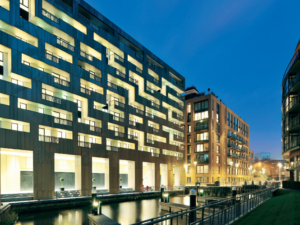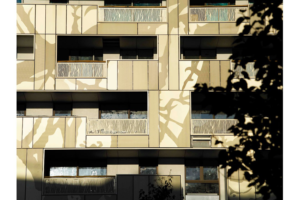Futurecity Founder Mark Davy is using the company’s 15th year in business to revisit 15 public art works curated by Futurecity from 2007 – 2023. The walk takes him across to meet the artists, architects and clients who were involved in often ambitious and complex art-projects. The 15 artworks represent a collaborative and multi-disciplinary approach to public art, which were rarely funded through 106 or philanthropic sources, but by taking an ‘embedded art’ approach, where the work has been part of architecture, infrastructure, and landscape design. In each of case the public art has been part of earlier placemaking and cultural strategies that took a wider look at how arts and culture might contribute to the regeneration of brownfield sites or as part of new developments in existing communities. The walk will conclude in November with aeries of talks and walks as part of the celebration of Futurecitys 15th year.
We begin the walk with artist Clare Woods dramatic design for Bramah House, a MAKE Architect residential block in Grosvenor Waterside in the City of Westminster. Futurecity developed a detailed public art strategy for the former dock site, which identified a number of ambitious largescale Art + Architecture, Engineering and Landscape partnerships. Other artworks and cultural projects were commissioned including ‘ShackStack’ by artist Richard Wilson RA and ‘Thames Stone’ by Erhardt Altenburger. The strategy also led to the new Chelsea Futurespace contemporary art gallery and the livery design for the ‘Tate to Tate River boat by Damien Hirst.
Artist Clare Woods, worked closely with Futurecity on the project, taking inspiration from her photos of the surrounding historic buildings, the railway, heritage dock, and the historic lime trees which had once lined the dockside. Clare was brought in at an early stage of the design and worked closely with MAKE architects as Clare’s drawing were blown up in scale and transposed onto the design of the facade of the residential block, through a process of etching onto its anodised aluminium panel. The vast etched façade now responds to changes of natural light as it hits different areas of the surface throughout the day. Their collaboration ensured other opportunities arose for the building including the idea of ‘driftwood’ balcony rails and laser cut balcony panels influenced by her drawings.
“It was hard to keep the vision going for so long. I worked on the project since 2004. As an artist, I’m used to working a lot faster. But it was an amazing experience to have a piece of work made at that scale. There is definitely a lot more scope for artists, designers, and architects to collaborate.” Artist, Clare Woods
“Reflecting on Clare Woods RA vast aluminium ‘tree’ facade and ‘drawing’ balconies and driftwood handrails for Grosvenor Waterside (2005-7) which are now such a landmark, I am reminded of how the Futurecity commission propelled her into a trajectory of other public commission works. The opportunity for artists to work ‘differently’ is part of Mark Davy the CEO of the company’s DNA”. Author, academic and curator Dr Jean Wainright
Artist / Clare Woods / https://www.clare-woods.com/
Architects / MAKE / https://www.makearchitects.com/
Development / Grosvenor Waterside / https://mygrosvenorwaterside.com/
Client / St James / https://www.berkeleygroup.co.uk/about-us/who-we-are/our-brands/st-james
Artist / Richard Wilson RA / https://futurecity.co.uk/portfolio/shack-stack-2/
Artist / Ekkehard Altenburger / https://futurecity.co.uk/portfolio/the-thames-stone-and-negative-fall/
Read more on Bramah House here


